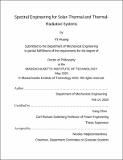| dc.contributor.advisor | Gang Chen. | en_US |
| dc.contributor.author | Huang, Yi,Ph. D.Massachusetts Institute of Technology. | en_US |
| dc.contributor.other | Massachusetts Institute of Technology. Department of Mechanical Engineering. | en_US |
| dc.date.accessioned | 2020-09-03T17:44:19Z | |
| dc.date.available | 2020-09-03T17:44:19Z | |
| dc.date.copyright | 2020 | en_US |
| dc.date.issued | 2020 | en_US |
| dc.identifier.uri | https://hdl.handle.net/1721.1/127052 | |
| dc.description | Thesis: Ph. D., Massachusetts Institute of Technology, Department of Mechanical Engineering, May, 2020 | en_US |
| dc.description | Cataloged from the official PDF of thesis. | en_US |
| dc.description | Includes bibliographical references (pages 224-239). | en_US |
| dc.description.abstract | Increasing energy efficiency for power generation and reduction of energy consumption are two important venues to address the energy supply and global warming challenges we face today. Radiation from the sun and terrestrial heat sources can be harvested for power generation. It is also an important heat transfer channel, with which one can control in order to regulate the temperature of objects. In this thesis, we focus on strategies to harvest and control solar and thermal radiation, with the goals (1) to improve power generation efficiency using solar and thermal photovoltaics and (2) to reduce the energy consumption used to maintain human comfort in built environments. Solar radiation, as one of the most abundant energy sources on Earth, is now harvested by photovoltaics around the world. While solar photovoltaics already has reached considerable efficiencies, there is still room for improvement. | en_US |
| dc.description.abstract | One fundamental limit in solar photovoltaics is the discard of photons with energy smaller than the material bandgap. Another challenge for solar PVs, due to the intermittent nature of solar power, is the lack of low-cost electricity storage systems that provide electricity on-demand. Solar thermal systems, on the other hand, can dispatch energy on-demand due to low-cost of thermal storage systems. Hybrid systems that combine solar PV and solar thermal systems can potentially harvest solar energy at higher efficiency and provide more dispatchable sources of energy. In the first part of my thesis, we designed and experimentally tested a spectral-selective, thermally-conductive component to be used in such hybrid solar-PV thermal system. | en_US |
| dc.description.abstract | The component can direct part of the solar spectrum to the photovoltaics and to absorb the rest of the spectrum for use in a thermal system, thereby harvesting the entire solar spectrum with an energy conversion efficiency close to 23%, and with over 40% dispatchable electricity generated from thermal energy. The photovoltaic energy conversion efficiency can also improve by recycling photons with energy smaller than the material bandgap. In a thermo-photovoltaic system, low-energy photons can be designed to reflect back to the radiation source, and therefore energy carried by these photons can be re-used. Thermo-photovoltaic devices also showed great potential to provide low-cost, dispatachable electricity when combined with high-temperature thermal storage systems and concentrated solar power. In the second part of my thesis, we have designed and optimized a practical, crystalline-Si based thermo-photovoltaic cell to be fabricated on double-side polished wafers. | en_US |
| dc.description.abstract | The Si-based TPV cell, combined with a 2300K gray radiator, can potentially reach 40% energy conversion efficiency. We have evaluated and optimized the Si-TPV performance with comprehensive considerations of components in the photovoltaic cell, including doping and junction depth, front and back surface field, passivation layer, back reflector, front metallization, as well as tolerance to roughness introduced in fabrication. Experimental tests have been conducted on doped Si samples with back reflectors, and identified potential pathways to further reduce optical and electrical losses. The maturity of the Si PV technologies and its relatively low cost points to great promise of high-efficiency thermo-photovoltaic devices for high-temperature thermal energy storage. Thermal radiation is also integral to the regulation of heat balance and temperatures of human body. Spaces in built environments are typically kept at near-ambient temperatures for human thermal comfort. | en_US |
| dc.description.abstract | However, heating and cooling of spaces consume 40% of the total energy used in the US. Instead of regulating temperature in vast spaces, local regulation of heat near human bodies can potentially save large amounts of energy. In the third part of my thesis, we study the use of fabrics to regulate skin temperatures of the human body by controlling the input and output radiation channels of the human skin, an important yet largely under-studied channel for body temperature regulation. We then propose desired spectral properties of fabrics for both heating and cooling purposes, and in both indoor and outdoor environments. Finally, we investigate via both simulation and experiments, how morphology and material of polymer-based fabrics can be used to achieve the desired spectral properties. | en_US |
| dc.description.statementofresponsibility | by Yi Huang. | en_US |
| dc.format.extent | 239 pages | en_US |
| dc.language.iso | eng | en_US |
| dc.publisher | Massachusetts Institute of Technology | en_US |
| dc.rights | MIT theses may be protected by copyright. Please reuse MIT thesis content according to the MIT Libraries Permissions Policy, which is available through the URL provided. | en_US |
| dc.rights.uri | http://dspace.mit.edu/handle/1721.1/7582 | en_US |
| dc.subject | Mechanical Engineering. | en_US |
| dc.title | Spectral engineering for solar-thermal and thermal-radiative systems | en_US |
| dc.type | Thesis | en_US |
| dc.description.degree | Ph. D. | en_US |
| dc.contributor.department | Massachusetts Institute of Technology. Department of Mechanical Engineering | en_US |
| dc.identifier.oclc | 1191716251 | en_US |
| dc.description.collection | Ph.D. Massachusetts Institute of Technology, Department of Mechanical Engineering | en_US |
| dspace.imported | 2020-09-03T17:44:18Z | en_US |
| mit.thesis.degree | Doctoral | en_US |
| mit.thesis.department | MechE | en_US |
